
to enable students to explore the air element using the stem and 5 E plan to guide them to create new products with engineering
- Subject:
- Early Childhood Development
- Material Type:
- Activity/Lab
- Author:
- Selver Aydım Ucur
- Date Added:
- 05/12/2021

to enable students to explore the air element using the stem and 5 E plan to guide them to create new products with engineering
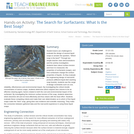
Student teams are challenged to evaluate the design of several liquid soaps to answer the question, “Which soap is the best?” Through two simple teacher class demonstrations and the activity investigation, students learn about surface tension and how it is measured, the properties of surfactants (soaps), and how surfactants change the surface properties of liquids. As they evaluate the engineering design of real-world products (different liquid dish washing soap brands), students see the range of design constraints such as cost, reliability, effectiveness and environmental impact. By investigating the critical micelle concentration of various soaps, students determine which requires less volume to be an effective cleaning agent, factors related to both the cost and environmental impact of the surfactant. By investigating the minimum surface tension of the soap, students determine which dissolves dirt and oil most effectively and thus cleans with the least effort. Students evaluate these competing criteria and make their own determination as to which of five liquid soaps make the “best” soap, giving their own evidence and scientific reasoning. They make the connection between gathered data and the real-world experience in using these liquid soaps.
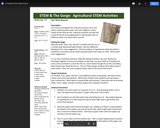
In this lesson, students will investigate seeds and the process of seeds growing to become the food we eat. Includes activity instructions, extension activities, songs, and a vocabulary list.
NGSS: Partially meets 2-LS2-1, Extension activities meet 4-LS1-1, 5-LS-1
Common Core: W.2.7, W.2.8, Extension activities meet MD.K, MD.1, MD.2.1, MD.3.3, MD, 4.4, MD.5
Social Sciences: 3.12, 4.12
Time: 45 minutes
Materials: "Seed, Soil, Sun" or other book about seed germination and plant growth, clear plastic cups, paper cups, paper towels, seeds, water
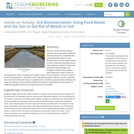
Over the course of three sessions, students act as agricultural engineers and learn about the sustainable pest control technique known as soil biosolarization in which organic waste is used to help eliminate pests during soil solarization instead of using toxic compounds like pesticides and fumigants. Student teams prepare seed starter pots using a source of microorganisms (soil or compost) and “organic waste” (such as oatmeal, a source of carbon for the microorganisms). They plant seeds (representing weed seeds) in the pots, add water and cover them with plastic wrap. At experiment end, students count the weed seedlings and assess the efficacy of the soil biosolarization technique in inactivating the weed seeds. An experiment-guiding handout and pre/post quizzes are provided.

Systems Neuroscience Laboratory consists of a series of laboratories designed to give students experience with basic techniques for conducting systems neuroscience research. It includes sessions on anatomical, neurophysiological, and data acquisition and analysis techniques, and the ways these techniques are used to study nervous system function. Training is provided in the art of scientific writing with feedback designed to improve writing skills. Assignments include weekly preparation for lab sessions, two major research reports and a series of basic computer programming tutorials (MATLAB). The class involves the use of experimental animals. Enrollment is limited.
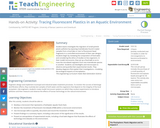
Student teams investigate the migration of small-particle plastic pollution by exposing invertebrates found in water samples from a local lake or river to fluorescent bead fragments in a controlled environment of their own designs. Students begin by reviewing the composition of food webs and considering the ethics of studies on live organisms. In their model microcosms, they set up a food web so as to trace the microbead migration from one invertebrate species to another. Students use blacklights and microscopes to observe and quantify their experimental results. They develop diagrams that explain their investigations—modeling the ecological impacts of microplastics.
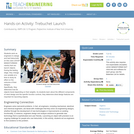
Students work as engineers to design and test trebuchets (in this case LEGO® MINDSTORMS® robots) that can launch objects. During the testing stage, they change one variable at a time to study its effect on the outcome of their designs. Specifically, they determine how far objects travel depending on their weights. As students learn about the different components of robot design and the specific function controls, they determine what design features are important for launching objects.

Students conduct a simple test to determine how many drops of each of three liquids water, rubbing alcohol, vegetable oil can be placed on a penny before spilling over. Because of their different surface tensions, more water can be piled on top of a penny than either of the other two liquids. However, the main point of the activity is for students to come up with an explanation for their observations about the different amounts of liquids a penny can hold. To do this, they create hypotheses that explain their observations, and because middle school students are not likely to have prior knowledge of the property of surface tension, their hypotheses are not likely to include this idea. Then they are asked to come up with ways to test their hypotheses, although they do not need to actually conduct these tests as part of this activity.

Astronaut Kate Rubins became the first person to sequence DNA in space. She eventually sequenced over 2 billion base pairs of DNA during a series of experiments to analyze sequencing in microgravity.

Wind Turbine project to build simple rotors, and test for Gravitaitonal Potential Energy.

This resource is a video abstract of a research paper created by Research Square on behalf of its authors. It provides a synopsis that's easy to understand, and can be used to introduce the topics it covers to students, researchers, and the general public. The video's transcript is also provided in full, with a portion provided below for preview:
"A new report in the journal Biochemistry and Molecular Biology Education describes a laboratory activity meant to help students understand allelopathy – a type of chemical warfare used by plants to secure the resources needed to grow. In this process, plants release biochemicals that affect the growth or development of neighboring plants. It is a common tactic of invasive plant species. The mechanism has also been used in agricultural production systems as a sustainable and organic way to manage weeds and soil fertility. For example, horseradish produces the molecule sinigrin, which is hydrolyzed in the presence of the enzyme myrosinase to generate allyl isothiocyanate, or AITC. AITC has been shown to have allelopathic effects on lettuce, including reduced and delayed seed germination rates, decreased root hair growth, and decreased root length. Mustard green also contains AITC and is widely utilized to control weed growth in current agriculture production..."
The rest of the transcript, along with a link to the research itself, is available on the resource itself.